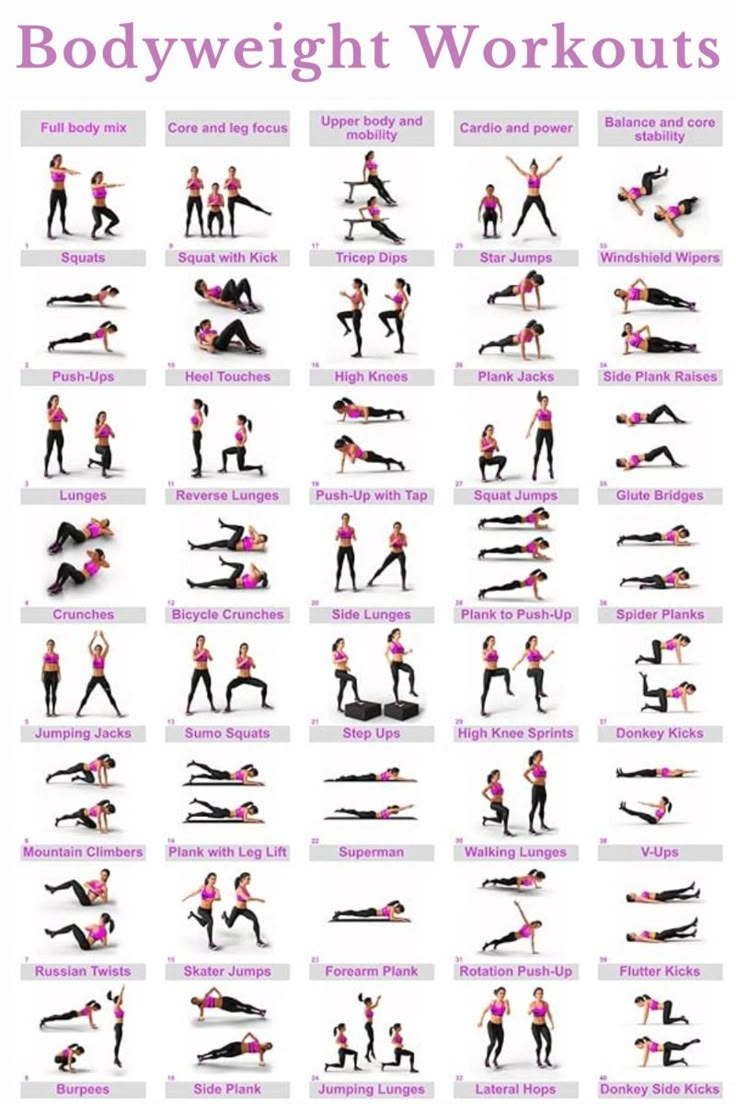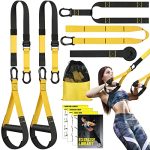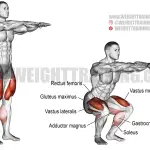Are you looking to get fit without the need for expensive gym equipment? You’re not alone.
Many people are discovering the power of bodyweight exercises, which allow you to harness the weight of your own body to build strength, flexibility, and endurance. The best part? You can do them anywhere, anytime. Picture this: achieving your fitness goals without a single piece of equipment.
It’s not just a dream; it’s your new reality. In this blog post, you’ll find a comprehensive list of bodyweight exercises that will transform your workout routine. By the time you reach the end, you’ll wonder how you ever exercised any other way. Curious to find out more? Keep reading to uncover the secrets of a fitter, stronger you.
Benefits Of Bodyweight Exercises
Bodyweight exercises offer numerous advantages for fitness enthusiasts. They are perfect for anyone seeking effective workouts without equipment. These exercises can be performed anywhere, making them convenient and versatile. Discover the benefits of integrating bodyweight exercises into your routine.
Improved Muscle Strength
Bodyweight exercises help build muscle strength efficiently. They engage multiple muscle groups at once. This leads to balanced muscle development. Push-ups, squats, and lunges are excellent examples. They enhance core strength and overall muscle tone.
Enhanced Flexibility
Many bodyweight exercises improve flexibility. Movements like yoga poses and stretches increase range of motion. Regular practice helps maintain joint health. Improved flexibility also reduces the risk of injury.
Cardiovascular Fitness
Bodyweight workouts boost cardiovascular health. Exercises such as jumping jacks and burpees raise heart rate. This improves heart and lung efficiency. Regular practice enhances stamina and endurance.
Weight Management
Bodyweight exercises aid in weight management. They burn calories effectively. High-intensity workouts promote fat loss. Consistent practice helps maintain a healthy weight.
Convenience And Cost-effectiveness
Bodyweight exercises require no equipment. This makes them convenient and cost-effective. Perform workouts at home or outdoors. Save money on gym memberships. Enjoy the flexibility of exercising anytime, anywhere.
Adaptability For All Fitness Levels
Bodyweight exercises suit all fitness levels. Beginners can start with basic movements. Advanced athletes can increase intensity. Modify exercises to match your fitness goals. This adaptability makes them ideal for everyone.
Mental Health Benefits
Regular bodyweight exercise boosts mental well-being. Physical activity releases endorphins. These improve mood and reduce stress. Exercise also enhances focus and concentration. Enjoy a happier, healthier mind.
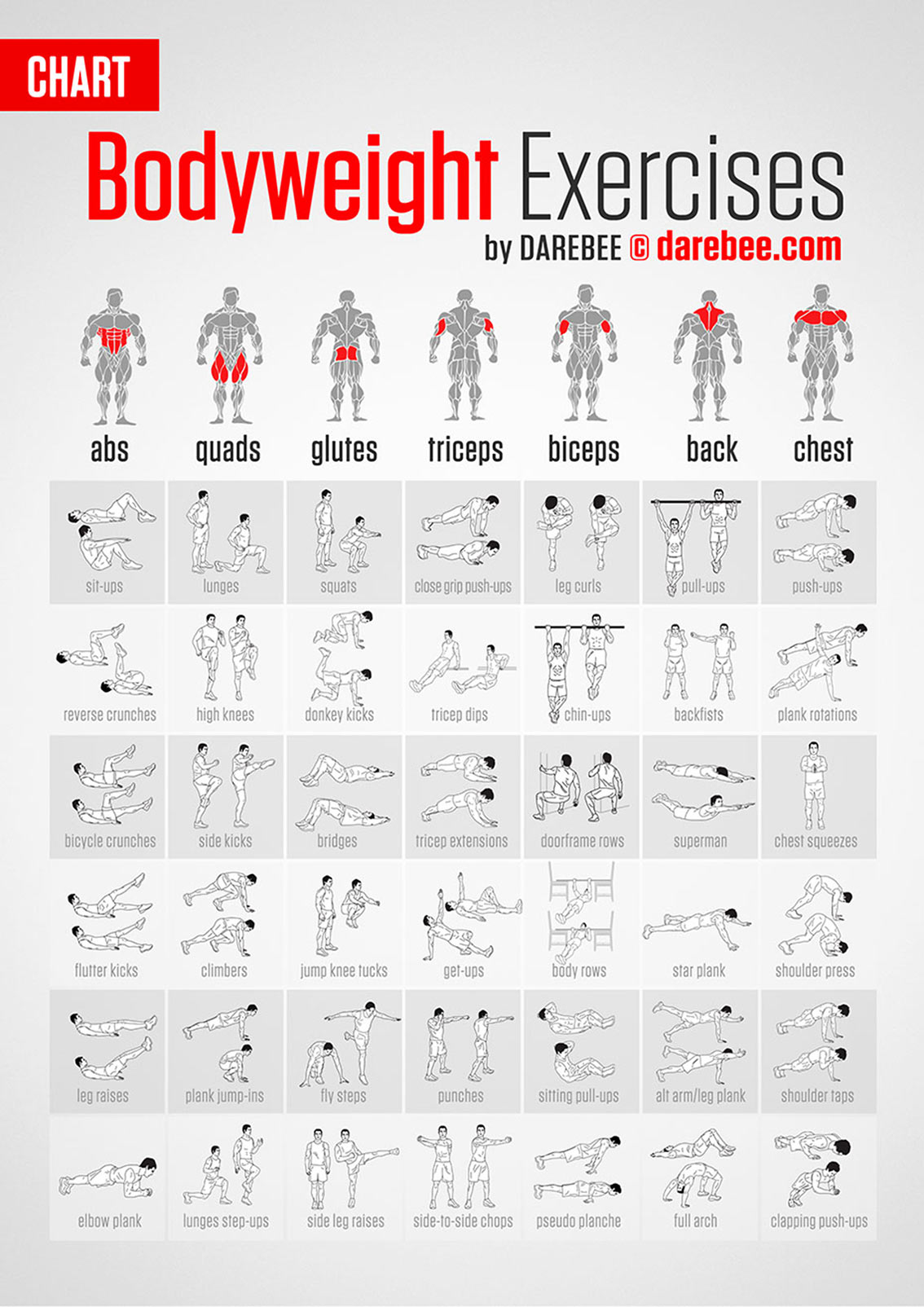
Credit: www.infogrades.com
Upper Body Workouts
Bodyweight exercises build upper body strength effectively. They are accessible and versatile. No equipment needed. Just your body and determination. Whether at home or in a park, you can strengthen your arms, chest, and shoulders. This section explores key exercises for a strong upper body.
Push-ups Variations
Push-ups are a staple in upper body workouts. Standard push-ups target the chest, shoulders, and triceps. For more challenge, try decline push-ups. Place your feet on a raised surface. This variation increases difficulty and targets the upper chest. Wide push-ups emphasize the chest. Keep your hands wider than shoulder-width. Diamond push-ups focus on triceps. Form a diamond shape with your hands under the chest.
Pull-ups And Chin-ups
Pull-ups build back and arm strength. Grip a bar with palms facing away. Pull your body up until your chin is above the bar. Chin-ups are similar but easier. Grip the bar with palms facing you. They focus more on the biceps. Both exercises develop the upper body effectively. You can use a tree branch or a playground bar for these.
Dips And Tricep Exercises
Dips target the triceps and chest. Use parallel bars or a sturdy chair. Lower your body until your elbows are at a 90-degree angle. Then push back up. For tricep exercises, try close-grip push-ups. Keep hands close together. This focuses on the tricep muscles more. Tricep extensions can also be done using a bench or low table.
Core Strengthening Moves
Strengthening your core is essential for overall fitness. A strong core provides stability, improves posture, and supports every movement you make. Whether you’re lifting a heavy grocery bag or trying to balance on one foot, your core is the powerhouse of your body. Let’s dive into some effective core strengthening moves that you can do anywhere, anytime.
Planks And Variations
Planks are a staple for core workouts. They engage multiple muscle groups and challenge your endurance. Start with a traditional plank by holding a push-up position. Keep your body straight and avoid sagging your hips.
Want to push your limits? Try side planks. This variation targets your obliques and gives you a more intense burn. If you enjoy a bit of movement, consider plank taps. Tap each shoulder with the opposite hand while maintaining your plank position. These variations keep your workouts dynamic and fun.
Crunches And Sit-ups
Crunches and sit-ups are classic exercises known for their ability to target the abdominal muscles. Lie on your back with knees bent and feet flat on the ground. Place your hands behind your head and lift your upper body towards your knees.
Crunches focus more on the upper abs, while sit-ups engage the entire core. Try mixing them up. Instead of sticking to one, alternate between the two for a well-rounded routine. Have you ever felt that satisfying burn in your abs after a set of crunches? That’s your muscles getting stronger.
Russian Twists
Russian twists are an excellent choice for engaging the obliques. Sit on the ground with your knees bent and feet off the floor. Lean back slightly, and hold your hands together. Twist your torso side to side, tapping the ground next to you with your hands.
To make it more challenging, hold a weight or a water bottle while twisting. It adds resistance and intensifies the workout. Russian twists not only enhance core strength but also improve balance. Have you ever tried balancing on one leg? A strong core can make it easier.
So, which core exercise will you start with today? Remember, consistency is key to building a strong core. Find what works best for you and stick with it.
Lower Body Strength
Lower Body Strength is essential for maintaining balance, enhancing athletic performance, and ensuring overall body stability. Whether you’re an athlete or someone who simply wants to stay fit, focusing on your lower body can bring remarkable benefits. Think about how many activities—running, jumping, climbing stairs—rely on strong legs. Imagine the difference it could make in your daily life if you could improve your lower body strength with simple bodyweight exercises.
Squats And Lunges
Squats and lunges are classic exercises that target multiple muscle groups in your legs. Squats work your quadriceps, hamstrings, and calves. They also engage your core, making them an excellent full-body workout. Think about starting with a few sets of 10 reps. Challenge yourself by increasing the number as you get comfortable.
Lunges, on the other hand, focus on your thighs and glutes. They require balance and coordination, which can improve your stability. Try alternating lunges as you walk across your living room. Feel the burn as your muscles work hard to keep you steady. How does it feel to have more control over your movements?
Calf Raises
Calf raises are perfect for strengthening the lower part of your legs. Stand on your toes and lift your heels off the ground. Feel the stretch in your calves. You can do this while brushing your teeth or waiting for your coffee to brew. Adding calf raises to your routine can enhance your running speed and jump height. Can you imagine sprinting faster just by doing a few calf raises every day?
Glute Bridges
Glute bridges target your glutes and lower back. Lie on your back, bend your knees, and lift your hips towards the ceiling. This exercise is fantastic for building a strong foundation. It’s a simple move that you can perform while watching TV or listening to music. Feel your glutes engage as you lift. Have you noticed how a stronger lower body helps improve your posture?
As you incorporate these exercises into your routine, notice the changes in your strength and stability. Which exercise do you find most rewarding? Share your experiences and inspire others to join the journey towards a stronger lower body.
Full Body Routines
Full body routines are a great way to improve fitness. They engage multiple muscle groups at once. This saves time and increases efficiency. These exercises can be done anywhere, without special equipment. Perfect for busy schedules. Let’s explore some effective exercises for a full-body workout.
Burpees
Burpees are an intense full-body exercise. They boost strength and endurance. Start by standing with feet shoulder-width apart. Drop into a squat, placing hands on the ground. Kick your feet back into a plank position. Do a push-up, then jump your feet back to the squat. Stand up and jump, reaching your hands overhead. Repeat this sequence quickly for maximum effect.
Mountain Climbers
Mountain climbers target the core and cardiovascular system. Begin in a plank position. Your body should be straight from head to heels. Bring one knee towards your chest. Quickly switch legs, as if you are running in place. Maintain a steady pace for a good workout. Mountain climbers improve agility and coordination.
Jumping Jacks
Jumping jacks are simple yet effective. They get your heart pumping. Stand with your feet together and arms at your sides. Jump while spreading your legs and raising your arms overhead. Return to the starting position and repeat. This exercise enhances cardiovascular health and burns calories. It’s a great warm-up or main workout component.
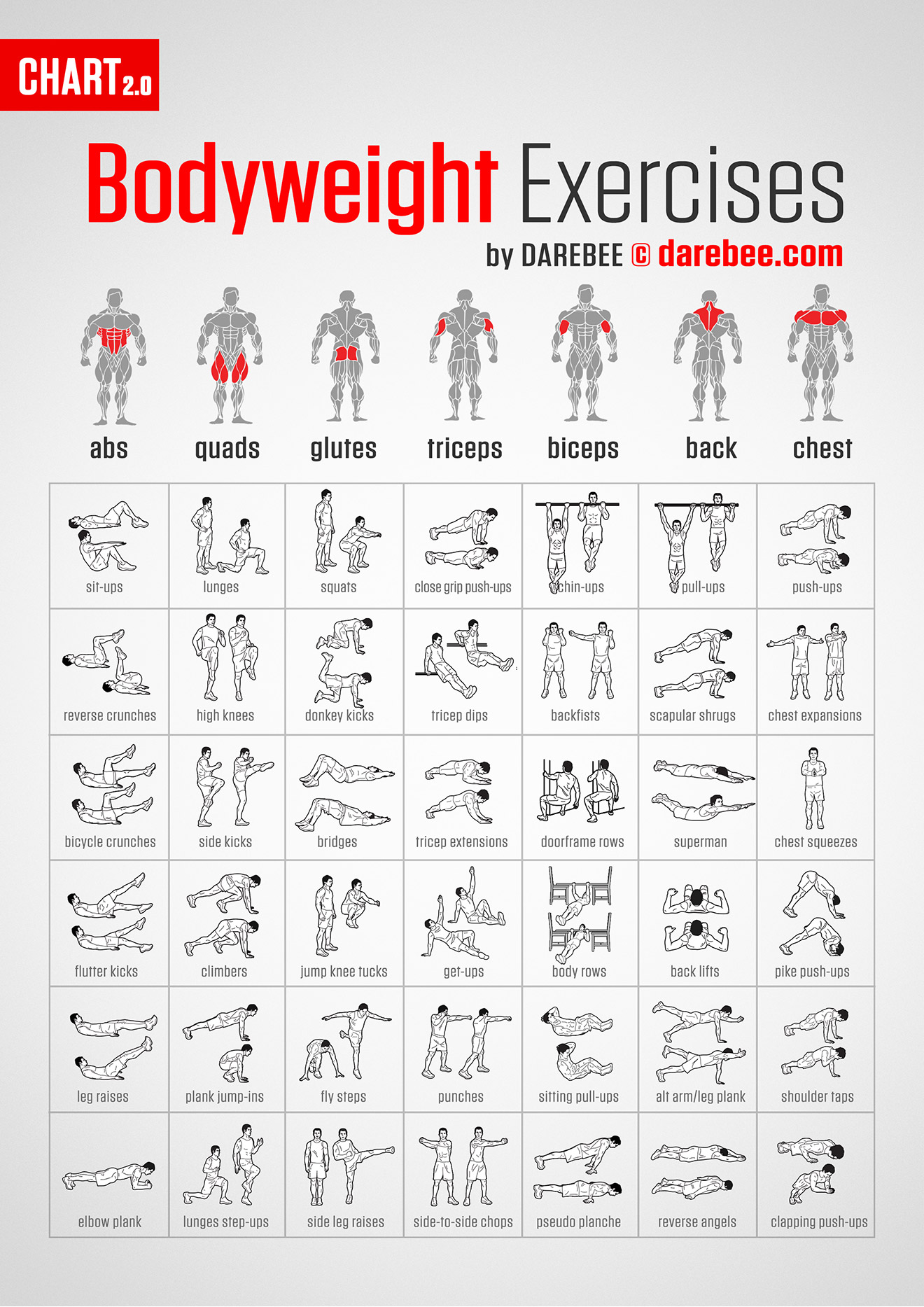
Credit: darebee.com
Flexibility And Balance
Flexibility and balance are crucial for a strong, healthy body. They enhance movement efficiency and prevent injuries. Bodyweight exercises offer a convenient way to improve these aspects. You don’t need any equipment. Just your body and some space.
Yoga And Stretching
Yoga combines flexibility and balance in one practice. It involves various poses to stretch muscles and improve posture. Downward Dog and Warrior poses are great for flexibility. They lengthen the spine and open up the hips. Stretching exercises complement yoga. They reduce muscle tension and increase joint mobility. Dynamic stretches like arm circles and leg swings prepare the body for movement. Static stretches maintain flexibility after a workout.
Balance Exercises
Balance exercises help stabilize the body. Standing on one leg is a simple way to test balance. It strengthens the ankle and improves core stability. Try incorporating movements like heel-to-toe walking. These exercises challenge your balance and coordination. They are essential for daily activities. Improving balance reduces the risk of falls and boosts confidence. Practice these exercises regularly to maintain a balanced body.
Creating A Balanced Workout Plan
Explore a variety of bodyweight exercises to create a balanced workout plan. Push-ups, squats, and lunges build strength. Planks and burpees enhance endurance. Great for home workouts.
Creating a balanced workout plan is crucial for achieving your fitness goals efficiently. It’s not just about doing random exercises; it’s about structuring them in a way that challenges your body while ensuring you’re not overworking any particular muscle group. With bodyweight exercises, you have the advantage of flexibility and adaptability. Whether you’re a beginner or an experienced athlete, you can tailor your workout plan to fit your needs.Understanding Your Fitness Goals
Before diving into exercise selection, take a moment to reflect on your fitness goals. Are you aiming for strength, endurance, or flexibility? Maybe it’s a mix of all three. Knowing your objectives helps you choose exercises that align with your aspirations. Set clear, achievable goals to keep yourself motivated.Mixing Strength And Cardio
Combining strength and cardio exercises creates a balanced workout. Strength exercises like push-ups and squats build muscle, while cardio exercises like jumping jacks and burpees boost your heart rate. Include a mix in your workout plan to keep it dynamic and engaging.Scheduling Rest Days
Rest days are just as important as workout days. They allow your muscles to recover and grow stronger. Avoid the trap of thinking more is always better. Overtraining can lead to injuries and burnout. Plan for regular rest days to maintain your progress and prevent setbacks.Adapting To Your Progress
Your body adapts to exercises over time, so it’s essential to adjust your workout plan accordingly. As you gain strength and endurance, increase the difficulty of your exercises. This might mean adding more repetitions or trying advanced variations. Keep challenging yourself to prevent plateaus.Staying Motivated
Keeping motivation high is often a challenge. Switch up your routine to keep things interesting. Incorporate new exercises or set mini-goals to achieve along the way. Remember the thrill of achieving your first push-up? Use similar milestones to fuel your journey. How can you keep the excitement alive in your workout routine? Creating a balanced workout plan with bodyweight exercises is about understanding your body and goals. It’s a journey of constant adaptation and listening to what your body needs. So, what’s your next step in crafting the perfect plan for you?Safety Tips And Common Mistakes
Bodyweight exercises offer a convenient workout option at home. Ensure proper form to avoid injuries and maximize benefits. Common mistakes include neglecting warm-ups and overestimating ability, leading to strain. Focus on controlled movements for effective results.
Embarking on a fitness journey with bodyweight exercises can be empowering and effective. Yet, ensuring safety and avoiding common pitfalls is crucial to prevent injuries and maximize results. This section will delve into practical safety tips and highlight common mistakes that could hinder your progress or even harm you.Understanding Your Limits
It’s important to listen to your body. If you’re new to exercise or trying a new move, start with less intensity and gradually increase. Pushing too hard can lead to injuries, setting back your progress. Have you ever felt a sharp pain during a workout? That’s your body signaling it’s time to stop.Maintaining Proper Form
Proper form is everything in bodyweight exercises. Poor posture can lead to strains and sprains. Keep your core engaged and your movements controlled. Think about your body alignment. Are your knees over your toes in a squat? Are your shoulders aligned with your wrists in a push-up? Small adjustments can make a huge difference.Warming Up And Cooling Down
Never skip a warm-up or cool-down. Warming up prepares your muscles for the workout ahead, reducing the risk of injury. Cooling down helps your body recover. A simple five-minute routine can include dynamic stretches like leg swings or arm circles. After your workout, spend a few minutes stretching to ease muscle tension.Breathing Techniques
Breathing is often overlooked but is vital for exercise efficiency. Holding your breath can cause unnecessary strain. Focus on a steady inhale and exhale. During a plank, try exhaling as you hold your position. This helps maintain a rhythm and keeps you focused.Avoiding Overtraining
Too much of a good thing can be harmful. Overtraining can lead to fatigue, decreased performance, and burnout. Balance your workout days with rest days. Your body needs time to recover and grow stronger. Have you considered incorporating rest days into your schedule?Using A Balanced Routine
A balanced routine targets all muscle groups. Focusing too much on one area can lead to imbalances and increased injury risk. Mix in exercises like push-ups, squats, and lunges. This variety ensures you’re building overall strength and not neglecting any part of your body.Seeking Professional Guidance
If you’re unsure about your technique, don’t hesitate to seek help. A fitness coach can provide valuable insights and personalized advice. Have you thought about joining a class or hiring a trainer? Sometimes, a little guidance can boost your confidence and efficiency. By keeping these tips in mind, you can enjoy a safe and effective workout routine. Remember, the goal is to enhance your strength and well-being, not jeopardize it. Are you ready to make the most out of your bodyweight exercises?Tracking Progress And Setting Goals
Tracking progress in bodyweight exercises helps improve fitness. Setting goals motivates daily workouts like push-ups, squats, and lunges. Simple routines build strength effectively.
Tracking your progress and setting goals is crucial when performing bodyweight exercises. It not only keeps you motivated but also helps you achieve your fitness objectives more effectively. Knowing where you stand can guide your workout strategy, making each session more meaningful. ###Why Track Your Progress?
Tracking progress gives you a clear picture of your improvements. Are you getting stronger or building endurance? Documenting your workouts helps answer these questions. You might notice you’re doing more reps or holding a plank longer than last month. This boosts your confidence and encourages you to push further. ###Setting Realistic Goals
Setting achievable goals is key to maintaining enthusiasm. Begin with small targets; aim to do one more push-up or shave seconds off your squat hold. Having realistic goals prevents burnout and keeps you focused. Celebrate small victories to fuel your motivation for bigger achievements. ###Tools For Tracking
Various tools can assist in tracking your progress. Fitness apps are a popular choice, offering features like workout logs and progress graphs. A simple notebook works wonders too. Jot down your exercise routine, reps, and feelings post-workout. This physical record serves as a tangible reminder of your growth. ###Reflecting On Your Journey
Reflection is an underrated aspect of tracking progress. Look back at your journey; recognize patterns, strengths, and areas needing improvement. Did you find some exercises easier than others? This reflection can guide your future workouts and help you adjust your goals accordingly. ###Engaging With A Community
Joining a fitness community can enhance your experience. Share your progress and goals with others, gaining support and inspiration. Communities offer tips and encouragement, making your journey less solitary. Are you ready to share your progress with others? ###Accountability Partners
Finding an accountability partner can be a game-changer. They keep you on track and celebrate milestones with you. An accountability partner can motivate you when you feel stuck, ensuring you don’t stray from your goals. Have you considered teaming up with someone? ###Adjusting Goals As You Progress
As you improve, it’s essential to reassess and adjust your goals. What seemed challenging initially might become easy over time. Changing your goals keeps your workouts exciting and prevents stagnation. Are you ready to set new benchmarks? Tracking your progress and setting goals can transform your workout routine. Embrace this strategy and watch your fitness journey unfold with purpose.
Credit: www.pinterest.com
Frequently Asked Questions
What Are Common Bodyweight Exercises?
Common bodyweight exercises include push-ups, squats, lunges, and planks. These exercises use your body weight for resistance. They are effective for building strength and improving flexibility. You can do them anywhere without any equipment, making them convenient for home workouts.
Can Bodyweight Exercises Build Muscle?
Yes, bodyweight exercises can build muscle. They engage multiple muscle groups simultaneously, promoting muscle growth. Progressively increasing reps or intensity can enhance muscle development. Combining them with a balanced diet and adequate rest supports muscle building. They are effective for beginners and advanced fitness enthusiasts.
Are Bodyweight Exercises Suitable For Beginners?
Bodyweight exercises are suitable for beginners. They offer a low-impact way to start fitness routines. Beginners can modify exercises for their fitness level. They help build foundational strength and improve balance. Starting with basic movements like squats and push-ups can gradually enhance fitness and confidence.
Do Bodyweight Exercises Burn Calories?
Bodyweight exercises burn calories effectively. They increase heart rate and engage multiple muscles. High-intensity bodyweight workouts can boost calorie burn. Combining exercises like burpees and jumping jacks can enhance calorie expenditure. Regular bodyweight workouts contribute to weight loss and improved cardiovascular health.
Conclusion
Bodyweight exercises offer a simple way to stay fit. No equipment needed. Perfect for home workouts and busy schedules. Push-ups, squats, and lunges build strength. Planks and bridges improve stability. Mix these exercises for balanced fitness. Start slow, increase intensity gradually.
Listen to your body, avoid injury. Consistency matters more than speed. Enjoy the process, see progress over time. Build a routine you love. Feel healthier, stronger, and more confident. Remember, it’s about enjoying the journey. Fitness should be fun, not a chore.
Stay active, stay healthy, and keep moving!
{ “@context”: “https://schema.org”, “@type”: “FAQPage”, “mainEntity”: [ { “@type”: “Question”, “name”: “What are common bodyweight exercises?”, “acceptedAnswer”: { “@type”: “Answer”, “text”: “Common bodyweight exercises include push-ups, squats, lunges, and planks. These exercises use your body weight for resistance. They are effective for building strength and improving flexibility. You can do them anywhere without any equipment, making them convenient for home workouts.” } } , { “@type”: “Question”, “name”: “Can bodyweight exercises build muscle?”, “acceptedAnswer”: { “@type”: “Answer”, “text”: “Yes, bodyweight exercises can build muscle. They engage multiple muscle groups simultaneously, promoting muscle growth. Progressively increasing reps or intensity can enhance muscle development. Combining them with a balanced diet and adequate rest supports muscle building. They are effective for beginners and advanced fitness enthusiasts.” } } , { “@type”: “Question”, “name”: “Are bodyweight exercises suitable for beginners?”, “acceptedAnswer”: { “@type”: “Answer”, “text”: “Bodyweight exercises are suitable for beginners. They offer a low-impact way to start fitness routines. Beginners can modify exercises for their fitness level. They help build foundational strength and improve balance. Starting with basic movements like squats and push-ups can gradually enhance fitness and confidence.” } } , { “@type”: “Question”, “name”: “Do bodyweight exercises burn calories?”, “acceptedAnswer”: { “@type”: “Answer”, “text”: “Bodyweight exercises burn calories effectively. They increase heart rate and engage multiple muscles. High-intensity bodyweight workouts can boost calorie burn. Combining exercises like burpees and jumping jacks can enhance calorie expenditure. Regular bodyweight workouts contribute to weight loss and improved cardiovascular health.” } } ] }
